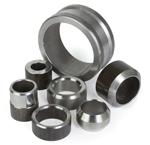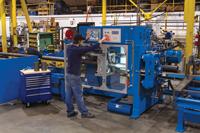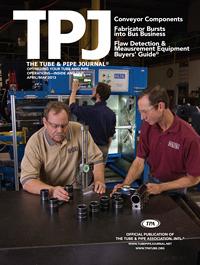- FMA
- The Fabricator
- FABTECH
- Canadian Metalworking
Categories
- Additive Manufacturing
- Aluminum Welding
- Arc Welding
- Assembly and Joining
- Automation and Robotics
- Bending and Forming
- Consumables
- Cutting and Weld Prep
- Electric Vehicles
- En Español
- Finishing
- Hydroforming
- Laser Cutting
- Laser Welding
- Machining
- Manufacturing Software
- Materials Handling
- Metals/Materials
- Oxyfuel Cutting
- Plasma Cutting
- Power Tools
- Punching and Other Holemaking
- Roll Forming
- Safety
- Sawing
- Shearing
- Shop Management
- Testing and Measuring
- Tube and Pipe Fabrication
- Tube and Pipe Production
- Waterjet Cutting
Industry Directory
Webcasts
Podcasts
FAB 40
Advertise
Subscribe
Account Login
Search
Conveyor components manufacturer relies on inverse lathe
Headstock rotates around stationary tube for precise, square cuts and material optimization
- April 8, 2013
- Article
- Tube and Pipe Fabrication
Few types of industrial machinery have to take a beating like mining equipment does. Constant exposure to heat, dust, dirt, and debris means that mining equipment has to be built to last.
Whether the target is common, like coal or iron ore, or something more exotic, such as gold or diamonds, miners have to move a lot of material, usually by conveyor. Every conveyor component has to stand up to quite a bit of use and certainly some abuse.
Goodman-Hewitt, Belton, S.C., a division of Joy Global, has been manufacturing industrial conveyor components, notably steel idler rolls, for more than 50 years. The rolls are assembled into various welded frames to make idlers, which are used with rubber belts to form conveyors for many types of aggregate material handling systems. Although the company has developed many standard sizes of rollers and idlers to suit repeat orders, many idlers are custom-made.
Conveyors are nothing new to mining; in fact, the conveyor market is very mature, a market in which product differentiation is difficult at best. Most purchasing decisions are based on price, delivery, and quality. Price has become the main issue, and the level of competition means the buyer can insist on zero defects and shipments in days rather than weeks.
Not Standing Idle
The staff at Goodman-Hewitt kept these criteria in mind as they started a program to update their cutting and grooving equipment. A central consideration was the high cost of material for making idler rolls. While labor and efficiency are important in the manufacturing of steel rolls, the staff was well aware that material cost reduction was the key to reducing the cost of making the idlers.
Material utilization was the first area the upgrade team concentrated on. It needed a way to maximize the number of rolls it cut from each standard 21-foot (mill-length) tube. Since the shortest roll was 9 in. long, any remnant shorter than 9 in. would be tossed into the scrap bin. As the number of roll lengths increased over the years, it had become increasingly difficult to maximize material utilization.
“The first criterion for a new cutting
machine was material optimization,” said Manufacturing Engineer Keavin Ramey. “We looked for a computerized system that could quickly and accurately maximize material usage.” An improvement of just 5 percent would have a tremendous favorable impact on the cost of the product, he said.
The second criterion was the capability to handle all of the tube diameters with little or no setup. This criterion was based on corporate pressure to reduce inventory, which is common in manufacturing these days. Goodman-Hewitt was asked to reduce inventory levels even as its customers were demanding shorter and shorter lead-times. The only way to meet these conflicting demands was to shorten the cycle time. An order would have to move through the factory in a matter of shifts rather than weeks. It would be necessary to run small lot sizes; the downside was a corresponding increase in the number of setups. Somehow Goodman-Hewitt would have to do this without affecting the product’s cost.
While the cycle time of the machine would be important, reducing setup time would save substantial amounts of money and simultaneously reduce the lead-time. This would also lead to an improvement in customer service and allow production to run many different styles of rollers on the same day without increasing costs.

Figure 1: Independent chucks grip the stationary tube on both sides of the cut, then the chucks reposition to chamfer the ID and OD of both cut ends.
The third criterion was product quality.
“The important areas are the squareness of the cut and the overall length, as these two dimensions are critical for optimal performance of the tapered roller bearings,” Ramey said. The machine would have to repeat precisely in these two areas without frequent calibration. The company was interested in a large, heavy, stable machine, with heavy-duty tool supports, to prevent variances in part length and squareness.
An Inverse Lathe
The result of the company’s research was a decision to purchase a Hautau tube cutting system. The system’s operating principle is the opposite of a lathe—it holds the tube stationary while a rotating headstock cuts and chamfers both ends (see Figure 1).
Two hydraulic chucks, securing both the incoming tube and the cutoff length, provide stability for square cuts and concentric chamfers. Servo-controlled feeders prevent slippage when moving the tube to the cutoff position, so cut lengths are accurate and repeatable. It also processes bowed and straight tubes without any difference in quality.
Setups. On the new machine, all tube loading, feeding, chucking, and cutting motions adjust automatically when the operator keys in the tube size, effectively automating the setup and nearly eliminating the setup time. The servo tube feeder eliminates length stops and adjustments and allows multilength cutting. Cut length setups and grooving programs can be stored for repeat jobs, and tool setup is a simple matter of using the screen prompts.
Each tube length is measured as it passes through the loader, so if the machine detects a short tube, the cut quantity adjusts without operator input.
Material Use. The machine’s length-control system allows the operator to program up to 10 cut lengths, and then choose the quantity and length combination setup with the shortest remnant. In Goodman-Hewitt’s application, this means producing up to three varying lengths from every length of incoming material.
Additional material saving comes from the ability to face the leading tube end instead of making a trim cut, and from the tube feeder’s ability to handle very short remnants.
“We no longer have to keep the drops and try to convert them into usable lengths,” Ramey said.
Product Quality and Overall Results. Goodman-Hewitt reports improved quality, which in turn has improved several downstream processes, a welcome benefit and additional cost savings.

Figure 2: The machine’s rotating-head design enables chamfering and grooving operations to be combined with the cutoff cycle.
The machine also has an additional benefit: machining. One of Goodman-Hewitt’s product lines requires internal and external chamfers and an external groove, and the new machine can handle these features (see Figure 2).
Furthermore, compared to Goodman-Hewitt’s previous process, the cutoff machine has cut cycle times literally in half, replacing two machines.
About the Publication
Related Companies
subscribe now

The Tube and Pipe Journal became the first magazine dedicated to serving the metal tube and pipe industry in 1990. Today, it remains the only North American publication devoted to this industry, and it has become the most trusted source of information for tube and pipe professionals.
start your free subscription- Stay connected from anywhere

Easily access valuable industry resources now with full access to the digital edition of The Fabricator.

Easily access valuable industry resources now with full access to the digital edition of The Welder.

Easily access valuable industry resources now with full access to the digital edition of The Tube and Pipe Journal.
- Podcasting
- Podcast:
- The Fabricator Podcast
- Published:
- 04/16/2024
- Running Time:
- 63:29
In this episode of The Fabricator Podcast, Caleb Chamberlain, co-founder and CEO of OSH Cut, discusses his company’s...
- Trending Articles
Team Industries names director of advanced technology and manufacturing

Orbital tube welding webinar to be held April 23

Chain hoist offers 60-ft. remote control range

Push-feeding saw station cuts nonferrous metals

Corrosion-inhibiting coating can be peeled off after use

- Industry Events
16th Annual Safety Conference
- April 30 - May 1, 2024
- Elgin,
Pipe and Tube Conference
- May 21 - 22, 2024
- Omaha, NE
World-Class Roll Forming Workshop
- June 5 - 6, 2024
- Louisville, KY
Advanced Laser Application Workshop
- June 25 - 27, 2024
- Novi, MI



























